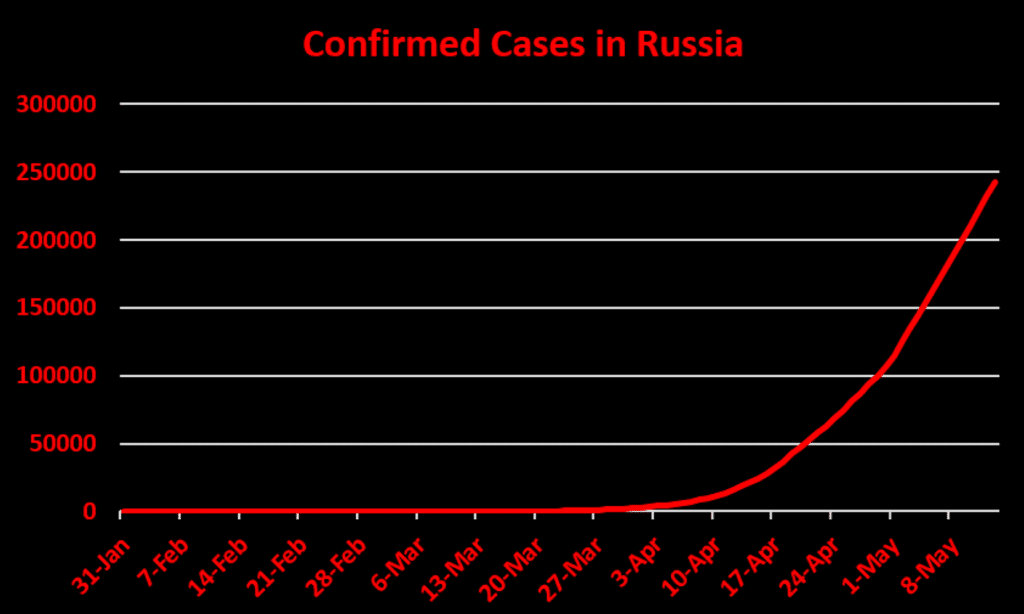May 14, 2020 | Policy Brief
COVID-19 in Russia
May 14, 2020 | Policy Brief
COVID-19 in Russia
President Vladimir Putin announced on Monday that Russia would begin easing its partial lockdown, even as the country’s caseload continues to soar. The virus-related lockdown, together with record low oil prices, has delivered twin shocks to the Russian economy and state budget, which depend heavily on revenue from oil exports.
Situation Overview
As of May 13, authorities have reported 242,271 confirmed cases, the second-highest number in the world, behind only the United States. The affected individuals include Russia’s recently appointed prime minister, the Kremlin’s spokesman, and two other cabinet members. With 10,028 new cases announced today, Russia’s official caseload has increased more than 80-fold since April 1. Yet the official tally is likely a severe underestimate. Moscow’s mayor said last week that the city’s true caseload likely totals almost 300,000, over three times the official count at the time. The city also suffered 1,980 unexplained “excess deaths” in April, triple its official COVID-19 death count that month.
A dearth of protective equipment has turned Russia’s hospitals into “super-spreader” hotspots. Yet Russia’s underpaid, overburdened healthcare workers face intense pressure to report only good news. Prosecutors have charged critical media and medical personnel with spreading “fake news” about the coronavirus, punishable by up to five years in prison under a newly passed law. Three doctors have mysteriously fallen from windows after drawing authorities’ ire. Police also violently detained Anastasia Vasilyeva, head of the opposition-aligned union Doctor’s Alliance, after she accused authorities of “openly lying” about the true extent of the crisis.
Russia’s COVID-19 epidemic owes its severity largely to the Putin regime’s delayed and opaque response. Fearing a political backlash, Putin was reluctant to impose lockdown measures. After quickly closing the Russia-China border, the federal government did little until late March to slow the virus’ spread. By mid-March, authorities still claimed Russia had under 150 COVID-19 cases, although a large spike in pneumonia cases suggests underreporting.
Not until March 25 did Putin make his first emergency address, declaring a “non-working” week that was later extended through May 11. Putin has nevertheless remained conspicuously absent throughout much of the crisis, distancing himself from the economic fallout by publicly delegating much of Russia’s COVID-19 response to regional leaders. But Russia’s “power vertical” cannot function without its tsar, and Russia’s response has been dysfunctional as a result.
 Source: JHU Coronavirus Response Center
Source: JHU Coronavirus Response Center
Data current as of 5:30 PM, May 13, 2020.
Implications
Amid plans to extend his 20-year reign, the Russian president has had to contend with falling public support. After initial reluctance, Putin was forced to postpone indefinitely an April 22 plebiscite designed to legitimize a constitutional amendment allowing him to remain president past 2024. He likewise had to postpone Russia’s much-anticipated May 9 Victory Day celebration, a much-anticipated event Putin hoped would help cement his role as “father of the nation.”
Economic forecasts predict GDP will shrink between 5 and 10 percent, alongside considerable drops in employment and household income. Yet government relief packages have been middling, amounting to just 2.8 percent of GDP, far less than offered by many Western countries. After his failed oil price war with Saudi Arabia, Putin partly has himself to blame for Russia’s economic woes.
The crisis has intensified popular resentment toward Putin, whose popularity was already slipping amid years of economic stagnation and falling incomes. At 59 percent, Putin’s approval rating has fallen to its lowest since 1999, down 10 points since February and a far cry from its high of 89 percent in 2015.
What to Watch for
Oil prices are not projected to fully recover until 2021, delaying economic relief. Despite enjoying a strong fiscal position, Russia is unlikely to deploy large-scale stimulus. Russia’s economic recovery may be sluggish as a result, deepening popular disaffection with Putin.
The government is also in the process of immunizing police from prosecution and expanding their latitude to use deadly force. While mass protests are less likely while the virus keeps spreading, there is greater risk of violent suppression of post-epidemic demonstrations.
John Hardie is research manager and Russia research associate at the Foundation for Defense of Democracies (FDD), where he also contributes to FDD’s Center on Economic and Financial Power (CEFP). For more analysis from John and CEFP, please subscribe HERE. Follow FDD on Twitter @FDD and @FDD_CEFP. FDD is a Washington, DC-based, nonpartisan research institute focusing on national security and foreign policy.